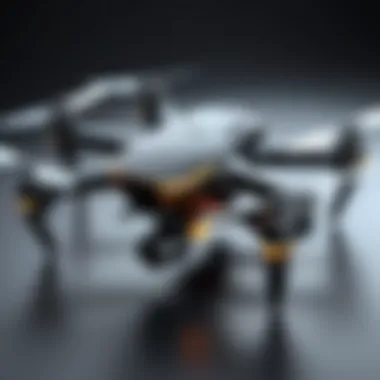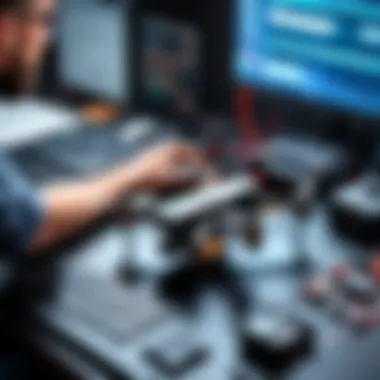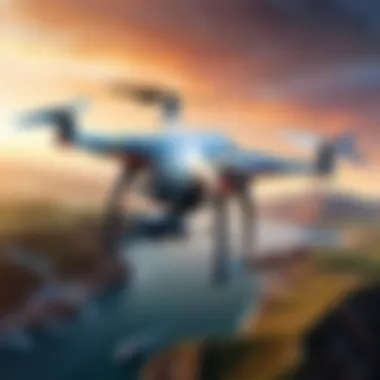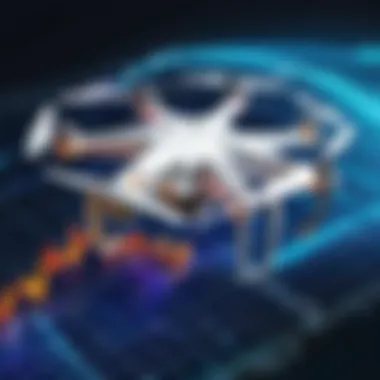Exploring Programmable Drone Kits with Cameras: A Guide


Intro
Programmable drone kits equipped with cameras represent a remarkable intersection of technology and creativity. These devices have gained notable traction among tech-savvy individuals seeking to explore new vistas in aerial photography, videography, and data collection. The growing accessibility of these kits allows a diverse group of users ranging from hobbyists to professionals to engage with this complex technology.
As we delve deeper into the intricacies of these programmable drones, it becomes crucial to understand their fundamental components, applications, and the vast market landscape surrounding them. This article meticulously unpacks the essential features and specifications that define these innovative flying machines, offering indispensable insights for informed decision-making.
Technical Specifications
Detailed Product Specs
When it comes to programmable drones, specifications determine their functionality and suitability for various tasks. Key specifications include:
- Weight: Lightweight models offer enhanced maneuverability.
- Camera Quality: Higher resolution cameras, such as 4K models, deliver superior imaging.
- Flight Time: The duration of flights, often ranging from 20 to 40 minutes, greatly influences usability.
- Range: This denotes how far the drone can operate from the controller, commonly between 500 meters to several kilometers.
Understanding these specifications is vital to choosing a drone that aligns with user needs and operational parameters.
Performance Metrics
Performance metrics are indicators of how well a drone operates in real-world scenarios. Important metrics include:
- Stability: Essential for capturing clear images and videos, especially in windy conditions.
- Speed: Most drones reach speeds of about 30 to 80 km/h.
- Response Time: Fast response times enhance pilot control.
These measurements offer a clearer picture of a drone's capabilities under various conditions.
Compatibility Information
Compatibility is paramount when choosing a programmable drone kit. Considerations include:
- Software: Check if the drone supports third-party applications for advanced functions.
- Accessories: Explore compatibility with different cameras or drones accessories like gimbals or battery packs.
- Operating Systems: Ensure that the drone works seamlessly with iOS or Android devices for easy control and monitoring.
Ensuring compatibility can significantly extend the utility of a drone kit.
Product Comparisons
Feature Comparisons
When evaluating different models, it's essential to compare their features. Notable drones in the market typically offer:
- Autonomous Flight: Some drones allow for pre-programmed flight paths.
- Object Tracking: Advanced drones can follow subjects automatically.
- Live Streaming: Certain models offer real-time video broadcasting.
These feature comparisons can highlight which device meets specific needs more effectively.
Price Breakdown
Cost is a significant factor in any purchase. Understanding the price spectrum helps in making informed choices. Entry-level drones might cost around $200, while high-end professional models can exceed $2,000. Price often reflects quality, durability, and technology.
User Experience Breakdown
User experience can vary greatly based on individual interactions. Factors to consider include:
- Ease of Use: Intuitive controls can enhance enjoyment for beginners.
- Customer Support: Robust support options lead to higher user satisfaction.
- Community Feedback: Engaging with online forums like Reddit can provide insight into real-world performance issues.
Practical Applications
Use Cases for Different Users
Different segments of users find distinct applications for programmable drones. These include:
- Recreational Users: Engage in aerial photography and exploration.
- Professional Filmmakers: Capture cinematic video with stunning angles.
- Surveyors: Collect data efficiently for mapping and inspections.
Recognizing these use cases helps select the right drone for the task at hand.
Recommended Configurations
The configuration can profoundly affect drone efficiency. Popular setups for various users might include:
- Camera upgrades for higher resolution
- Extra batteries for extended flight time
- Custom software solutions for specific operations
These configurations allow for tailored experiences according to user requirements.
Multi-Platform Performances
Some drones operate across different platforms, enhancing their versatility. Examining their cross-compatibility with various operating systems, cameras, and accessories can maximize operational efficiency.


Latest Trends
Industry Developments
The drone industry is continuously evolving. Recent developments include:
- Integration of AI for automated flight planning.
- Enhanced safety features with obstacle detection and avoidance systems.
- Broader regulatory acceptance across more countries.
These trends indicate a moving landscape, with implications for future users.
Emerging Technologies
New technologies are reshaping drones. Innovations include:
- Autonomous flight capabilities without pilot input.
- Advanced camera systems with artificial intelligence.
- Solar-powered drones for longer missions.
Future Predictions
Looking forward, it is expected that drones will become even more integrated into daily life. Applications might expand in fields like agriculture, search and rescue, and delivery services, transforming how industries operate.
Buying Guides
Recommended Products
Selecting a drone involves careful consideration of options available. Reputable models currently highlighting include DJI Mavic Air 2 and Parrot Anafi, known for their exceptional performance and features.
Purchasing Tips
When purchasing a drone, evaluate essential factors such as warranty, support, and reviews. Researching can lead to more satisfying purchases.
Warranty and Support Information
Lastly, understanding warranty and support structures can provide peace of mind. Many manufacturers offer one-year warranties with options for extended coverage. A responsive customer support system is also vital.
Understanding the features and specifications of programmable drone kits can greatly enhance the user experience and ensure satisfactory operational outcomes.
Understanding Programmable Drone Kits
Programmable drone kits with cameras represent a significant advancement in technology, appealing to hobbyists and professionals alike. These kits allow users to engage in aerial photography, surveillance, and robotic automation effectively. By understanding the components, programming options, and applications of these drones, individuals can make informed choices when selecting a suitable kit for their needs. Additionally, grasping the complexities of these systems enables users to harness their full potential, leading to innovative solutions across various fields.
Definition and Overview
A programmable drone kit is a set of components designed to allow users to create and customize their drones. These kits generally include a frame, motors, a camera system, and a control board, providing an all-inclusive approach for those wishing to delve into drone technology. The beauty of these kits lies in their flexibility; users can choose specific features to suit their intended applications.
Strong user communities often surround these kits, providing vast resources for support and advice. Thus, understanding the operational basics and features of programmable drone kits can greatly enhance user experience and capabilities.
Key Components of a Drone Kit
Frame
The frame of a drone kit serves as the structure. It holds everything together and provides the foundation for the entire drone. A reliable frame must balance strength and weight. Lightweight materials, like carbon fiber or plastic, are popular choices because they enhance maneuverability and reduce energy consumption. The frame must also be durable enough to withstand potential crashes, which can be common during flights. A well-designed frame contributes positively to the drone's aerodynamics, resulting in better flight performance.
Motors
Motors are vital for driving the propellers, and thus, they are crucial for flight. Brushless motors are the standard in programmable drone kits because they offer higher efficiency and longer life compared to brushed motors. The power-to-weight ratio of motors can significantly affect the overall performance and flight time. Choosing motors that align with the drone's framework and intended use is essential. An incorrect choice may lead to poor performance or, in worse cases, malfunction.
Camera System
The camera system is among the most appealing aspects of a programmable drone kit, especially for users interested in aerial photography. Many kits include high-definition cameras, allowing for clear and detailed photographs from above. The quality of the camera directly influences the drone’s potential for professional use. Some kits even offer modular camera systems, enabling users to upgrade or change cameras based on specific needs, enhancing versatility in applications.
Control Board
The control board is the brain of the drone. It processes inputs from the pilot and manages the motors' outputs. Control boards vary widely in terms of capabilities, with some supporting advanced programming features and remote control options. A robust control board can dramatically enhance the drone’s performance and allow for innovative operational modes. For instance, some control boards incorporate GPS and automated flight paths, turning an ordinary drone into a sophisticated tool for various applications.
Types of Cameras Used
HD Cameras
HD cameras are common in many drone kits. They offer a resolution of 1080p, delivering clear images suitable for casual photography and video. The affordability of HD cameras makes them a popular choice for hobbyists. However, they may lack some features found in higher-end models, such as better low-light performance. For beginners, these cameras provide an adequate introduction to aerial imaging.
4K Cameras
4K cameras stand out for their exceptional clarity, appealing to those requiring high-resolution images or professional footage. The ability to capture more detail allows for better post-editing possibilities, making them a preferred option among serious content creators. While they tend to be pricier, the investment can pay off with professional results and higher-quality outputs.
Thermal Imaging Cameras


In specific industries like search and rescue or infrastructure inspections, thermal imaging cameras prove invaluable. They detect heat differences and are used for locating missing persons, monitoring wildlife, or assessing building energy efficiency. These specialized cameras are generally more expensive and may require additional training for effective use, but their contributions in specialized applications can be profound.
Understanding the unique features and functions of camera systems in programmable drone kits enhances the ability to utilize them effectively for various applications.
Programming Drones: An In-depth Look
Understanding how to program drones is essential in maximizing their usage and functionality. Programming enables users to tailor their drone's behavior and capabilities to meet specific needs. This knowledge can significantly enhance the effectiveness of drones for various applications, such as aerial photography, inspection tasks, or search and rescue operations. Whether you are a hobbyist or a professional, the programming aspect opens up many possibilities.
Programming Languages and Software
Python
Python is renowned for its simplicity and readability. This programming language is widely used in the drone community. Its clear syntax allows for rapid development, making it an appealing option for both beginners and experienced programmers. The community support for Python is strong, offering numerous libraries that can facilitate drone programming.
One of the significant advantages of Python is its versatility in various applications. Whether integrating sensors or handling data processing, Python provides essential tools. Although there may be some performance trade-offs compared to lower-level languages, the overall ease of use makes Python a preferred choice for many.
JavaScript
JavaScript, primarily known for its role in web development, is also used in drone programming. Its event-driven nature allows developers to create dynamic and interactive drone applications. A notable characteristic of JavaScript is its ability to run in a browser, making it useful for creating user interfaces that can control drones via web applications.
JavaScript excels in real-time data handling, which is crucial for drones that require immediate feedback. However, its usability in performance-intensive scenarios may not match that of other languages. Still, for those who are already adept at JavaScript, it can be a convenient option for drone programming.
DroneKit
DroneKit is a powerful open-source framework specifically designed for programming drones. It simplifies complex tasks, making it accessible for developers looking to create custom drone applications. One of the key features of DroneKit is its compatibility with various autopilot software, allowing for effective communication between the drone and the programming interface.
The modularity of DroneKit makes it easy to extend its capabilities. Users can integrate additional features like GPS navigation or advanced sensor management. Although setting up DroneKit may require some technical knowledge, its flexibility offers significant potential for customized solutions. It is well-regarded in the drone community for its dedicated focus on drone technology.
Setting Up Programming Environment
Setting up an effective programming environment involves selecting the correct software and tools. This process enables programmers to write, test, and debug their code efficiently. Some common steps include:
- Choosing an Integrated Development Environment (IDE): Options such as Visual Studio Code or PyCharm can significantly streamline the coding experience.
- Installing necessary libraries: Based on the programming language, essential packages or plugins may be required to facilitate drone programming.
- Setting up a simulator: A drone simulator can help test code without risking the actual drone.
Establishing a robust programming environment can make a considerable difference in productivity and outcome.
Executing Basic Commands
When programming drones, starting with basic commands is crucial. These commands establish fundamental control over the drone. Key areas to focus on include:
- Takeoff and Landing: These commands allow the drone to ascend and descend safely, which is critical for any flying operation.
- Navigation: Implementing commands that direct the drone's path ensures it follows specific routes.
- Capturing Data: Programming the drone to collect images or sensor data can enhance its functionality.
Applications of Programmable Drones with Cameras
The use of programmable drones equipped with cameras has transformed various industries. The applications range from creative fields like aerial photography to critical scenarios like search and rescue operations. Understanding these applications is essential for tech enthusiasts aiming to leverage drone technology effectively.
Aerial Photography and Videography
Aerial photography has seen a significant evolution due to drone technology. Programmable drones allow photographers to capture stunning images from unique angles that were once challenging or impossible to achieve. The use of high-definition cameras on these drones enhances the quality of the visuals. Photographers can plan their flights, set specific routes, and even adjust camera settings remotely. This level of control provides opportunities to create compelling content for films, commercials, and personal projects. Furthermore, the integration of features like automated flight paths can result in consistent, professional-quality results across multiple shots.
Agricultural Monitoring
In agriculture, drones serve as valuable tools for monitoring crop health and assessing field conditions. By utilizing advanced camera systems, farmers can conduct aerial surveys to identify issues such as pest damage or water stress without needing ground inspections. This capability facilitates quicker and more informed decision-making. Implementing programmable drones in farmland can lead to improved yields and more efficient use of resources. For instance, when paired with data analytics, drones can provide insights into optimal planting times and fertilization strategies.
Search and Rescue Operations
The role of drones in search and rescue missions cannot be understated. Equipped with cameras, these drones provide real-time aerial views of disaster-stricken areas. They can be programmed to fly over vast spaces systematically, enhancing visibility for rescue teams. Drones can transmit video feeds to ground controllers, helping them to locate missing persons or assess damage. Moreover, thermal imaging cameras on drones can detect heat signatures, which is particularly useful in locating individuals in areas that are otherwise difficult to access.
Infrastructure Inspection
Drones serve a critical function in infrastructure inspection. With the capability to capture high-resolution images of structures such as bridges, buildings, and power lines, programmers can create custom inspection routines. This automates the assessment process and increases accuracy by reducing human error. Programmable drones can also navigate complex sites and gather data from locations that might be hazardous for personnel. The data collected can assist in predictive maintenance, allowing companies to address potential issues before they escalate into significant problems.
In summary, the application of programmable drones equipped with cameras is vast and impactful, shaping various industries practically and providing technological advantages that enhance productivity and safety.
Factors to Consider When Choosing a Programmable Drone Kit
Choosing a programmable drone kit with a camera is a significant decision for both enthusiasts and professionals. The right kit influences the quality of your aerial experiences. To make an informed choice, one must consider several key factors. This section discusses the most crucial aspects that impact the function and satisfaction derived from the kit.
Camera Quality and Features
The camera is often the centerpiece of a drone kit. The quality of the camera affects the overall performance of the drone, particularly in capturing images and videos. When evaluating camera quality, pay attention to resolution, frame rate, and lens specifications. For instance, a 4K camera offers sharper and more detailed images than standard HD cameras. Additionally, consider features such as image stabilization, which minimizes blurriness during flight, and low-light performance for shooting at dusk or in shaded areas.
Key Features to Consider:


- Zoom capabilities: Allows for capturing distant subjects without losing detail.
- Field of view: A wider field captures more in a single shot.
- Adjustable settings: Manual control over exposure, shutter speed, and ISO enhances creative possibilities.
Flight Time and Range
The flight time and range of a drone are essential for maximizing its effectiveness. Battery life can greatly affect how much you can achieve in one outing. Typical drone kits offer flight times between 20 to 40 minutes. Knowing the battery capacity helps in planning missions effectively.
Additionally, consider the control range, which dictates how far you can operate the drone from its point of launch. A longer range enables more extensive exploration or surveying areas of interest. Look for indicators of battery life remaining and features to return to the take-off point if the battery runs low or if it goes out of range.
Ease of Programming and Use
The user-friendliness of a programmable drone kit is paramount, particularly for newcomers. The programming environment should not only be accessible but also intuitive to navigate. Kits that use popular programming languages like Python or JavaScript are advantageous because they leverage existing skills. In addition, consider whether the drone supports multiple programming platforms and libraries.
An easy-to-follow setup process is beneficial for users with varying levels of technical expertise. Examine included documentation and community support available through forums or dedicated websites. This level of support can prove invaluable when resolving coding issues or enhancing functionality.
Helpful Resources:
- Community forums: Can provide real-time advice and troubleshooting tips.
- Tutorial videos: Are often available on platforms like YouTube for hands-on guidance.
Budget Considerations
Your budget plays a crucial role in deciding on a programmable drone kit. Drone kits can range significantly in price, influenced by the camera quality, flight time, and features. It’s important to weigh the price against the value offered by the kit.
While it may be tempting to opt for cheaper models, they often lack the features necessary for more complex projects. Thus, consider not just the current expenses but the potential long-term benefits of investing in a higher-quality kit. Assess whether additional costs, such as spare batteries or extra accessories, fit within your overall financial planning.
In summary, careful consideration of camera quality, flight time, ease of programming, and budget can greatly enhance your experience with programmable drone kits. The right choice can lead to a much more rewarding and successful journey in the world of drone technology.
Market Analysis of Programmable Drone Kits
The market analysis of programmable drone kits plays a crucial role in understanding the dynamics of this rapidly evolving technology. By examining current trends, major manufacturers, and consumer preferences, one can gain insights into the forces shaping the industry. Market analysis helps potential buyers make informed choices by evaluating what exists and predicting what might come next.
Current Trends in Drone Technology
In recent years, drone technology has witnessed significant advancements. A few notable trends include:
- Increased Automation: More drones are equipped with artificial intelligence, allowing them to perform tasks autonomously without human intervention.
- Enhanced Sensors: Drones are becoming more effective in data collection with improved sensors, aiding industries like agriculture and surveillance.
- Integration with IoT: The integration of drones with the Internet of Things has enabled real-time data sharing and analysis.
- User Accessibility: Cost-effective kits have made drones more accessible to a broader audience, fueling growth in hobbyist markets.
These trends indicate how programmable drone technology is moving toward greater versatility and efficiency.
Major Manufacturers and Brands
The competitive landscape is defined by several key manufacturers. Each brand brings its own strengths to the table. Some recognized names include:
- DJI: Known for high-quality cameras and user-friendly interfaces, DJI remains a leading brand in drone technology.
- Parrot: This brand emphasizes consumer drones but also offers kits for educational purposes.
- Autel Robotics: Known for innovation, Autel focuses on advanced aerial imaging and better customization options for users.
These companies continue to invest in research, driving the industry forward and influencing consumer choices.
Consumer Preferences and Insights
Understanding what consumers want is pivotal for success in the drone market. Recently, preferences show:
- Quality Over Cost: Many consumers prioritize camera quality and flight features over cheaper options.
- Ease of Use: Simple installation and programming have become crucial. Users prefer kits that are ready to use with minimal setup.
- Support and Community: Active user communities and reliable customer support influence purchasing decisions significantly.
This focus on user needs drives manufacturers to innovate and adapt their offerings, shaping the future of programmable drone kits.
Future Developments in Programmable Drone Technology
The landscape of programmable drone technology continues to evolve rapidly. Understanding future developments in this field is vital for all stakeholders, including technology enthusiasts, industry professionals, and regulatory bodies. Known for their ability to perform complex tasks autonomously, drones are finding relevance in various sectors, from agriculture to emergency services. This ongoing evolution offers potential benefits like improved efficiency, enhanced data collection, and cost savings. With automation and artificial intelligence at the forefront, these developments will influence how drones are built, operated, and legislated.
Advancements in AI and Automation
Artificial Intelligence (AI) is transforming programmable drone technology. One significant leap is the integration of machine learning algorithms that allow drones to analyze data in real-time. For instance, drones can autonomously identify objects, assess environments, and make informed decisions based on the information gathered. Such advancements will lead to better operational efficiency, especially in areas like surveillance and monitoring. Drones equipped with AI can compile large datasets quickly, providing valuable insights that would be hard to gather manually.
Moreover, automation will reduce the need for manual piloting. This change will enable even non-experts to operate drones effectively. Automated systems may handle complex flying maneuvers or navigation, thereby widening the user base. As these technologies mature, we can expect smarter, more responsive drones that can adapt to various conditions.
Integration with Other Technologies
As programmable drones become more sophisticated, there will be an increasing demand for integration with other technologies. The Internet of Things (IoT) is one such technology whose convergence with drones could enhance their capabilities. For instance, drones connected to IoT networks could share data instantly, facilitate remote monitoring and provide real-time updates to users.
Additionally, integration with cloud computing will allow drones to leverage vast processing power. This setup can improve data handling and storage while enabling more complex computations for tasks like 3D mapping or environmental modeling. The fusion of drones with augmented reality (AR) is another exciting avenue. This could provide operators with an immersive experience, improving situational awareness during flights.
Legislative Changes and Their Impacts
As drone technology evolves, so do the laws governing their use. Legislation has struggled to keep pace with advancements, creating a complex environment for drone operators. Future developments may bring significant changes to regulatory frameworks aimed at ensuring public safety while promoting innovation.
Regulatory bodies may introduce clearer guidelines, focusing on data privacy, airspace usage, and flight operation standards. Understanding these changes is crucial. For example, new laws could dictate where and how drones can operate, leading to potential restrictions or enhanced opportunities for commercial applications.
Additionally, compliance with evolving regulations could influence the design and functionality of programmable drones. Manufacturers may need to incorporate features that address legal requirements, such as geofencing technologies that restrict flights in sensitive areas.
Keeping abreast of legislative changes is essential for navigating the future of drone technology. It shapes what is possible and defines market opportunities.
In summation, the future developments in programmable drone technology present an exciting yet complex picture. The advancements in AI and automation promise to streamline operations, integration with other technologies could enhance functionality, and legislative changes will play a crucial role in shaping the industry. Understanding these factors equips stakeholders to make informed decisions in a rapidly changing environment.







